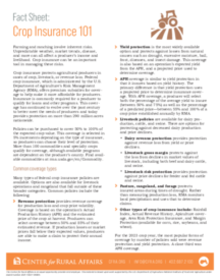Farm and Food
Policy
Para la versión en español de esta historia, por favor oprima aquí.
Farming and ranching involve inherent risks. Unpredictable weather, market trends, disease, and more can all affect a producer’s income and livelihood.
Crop insurance can be an important tool in managing these risks. Crop insurance protects agricultural producers in cases of crop, livestock, or revenue loss. Federal crop insurance, which is administered by the U.S. Department of Agriculture’s Risk Management Agency (RMA), offers premium subsidies for coverage to help make it more affordable for producers. Insurance is commonly required for a producer to qualify for loans and other programs. This coverage has continued to evolve over the past century to better meet the needs of producers and today provides protection on more than 290 million acres nationwide.
Policies can be purchased to cover 50% to 100% of the expected crop value. This coverage is selected in 5% increments depending on the type of insurance, so producers can choose their level of protection. More than 100 commodities and specialty crops qualify for coverage, although available programs are dependent on the producer’s county. Find available commodities at rma.usda.gov/en/Commodity.
Farming and ranching involve inherent risks. Unpredictable weather, market trends, disease, and more can all affect a producer’s income and livelihood.
Crop insurance can be an important tool in managing these risks. Crop insurance protects agricultural producers in cases of crop, livestock, or revenue loss. Federal crop insurance, which is administered by the U.S. Department of Agriculture’s Risk Management Agency (RMA), offers premium subsidies for coverage to help make it more affordable for producers. Insurance is commonly required for a producer to qualify for loans and other programs. This coverage has continued to evolve over the past century to better meet the needs of producers and today provides protection on more than 290 million acres nationwide.
Policies can be purchased to cover 50% to 100% of the expected crop value. This coverage is selected in 5% increments depending on the type of insurance, so producers can choose their level of protection. More than 100 commodities and specialty crops qualify for coverage, although available programs are dependent on the producer’s county. Find available commodities at rma.usda.gov/en/Commodity.


